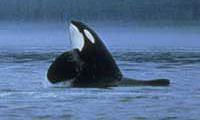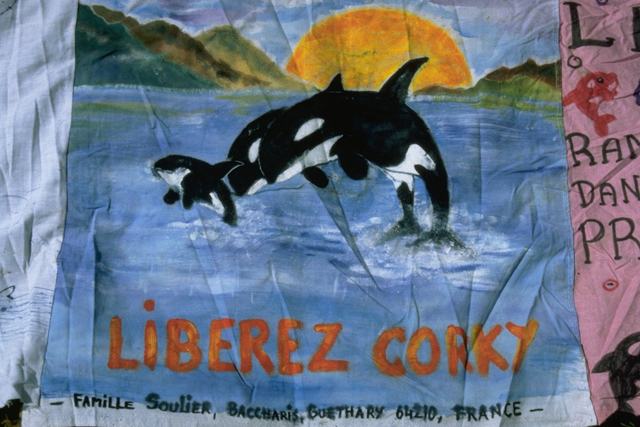The Latest News on Corky - December 2015
Corky’s Saddest AnniversaryIncredibly, December 11 2015 marks the 46th anniversary of Corky’s capture in 1969. There was a huge storm that tragic night, much like the one that is battering Canada’s west coast today, causing power outages and ferry cancellations. For some unknown reason, perhaps the weather, perhaps seeking disappeared relatives, perhaps for some other purpose, Corky’s family decided to swim through the narrow entrance of Pender Harbour on the Sunshine Coast north of Vancouver B.C. The evening was pitch black but their entry was noticed and word spread. Fishermen who had previously captured orcas in Pender Harbour sprang into action. By morning, the orcas were trapped behind nets and soon on offer to the developing marine entertainment industry. Corky was sold to Marineland of the Pacific near Los Angeles, where she joined 4 other captives, including a male named Orky who had been captured in Pender Harbour the year before. One by one the other captives died, leaving just Corky and Orky alive in the Marineland tank. When Corky was 10 years old they mated and Corky became pregnant. When her first baby died just 16 days old she became pregnant again, and when that baby died she became pregnant again. The cycle was repeated until Corky’s last baby, her 7th, was found as an aborted foetus on the bottom of the tank. Six months later, in December 1989 she and Orky were sold to SeaWorld and moved to San Diego. Corky stopped ovulating soon after, so the dismal cycle of births and deaths ended. A year and a half after arriving at SeaWorld, Orky died, leaving Corky in the company of orcas captured in Icelandic waters. Year after year passed, with Corky endlessly circling her tank. Despite her isolation from everything that had nurtured her, Corky survived. Today, she is the longest living and oldest captive orca, matched only by Lolita, another orca who was captured a year after Corky and still survives in a tank at the Miami Seaquarium. Their endurance is remarkable. Both have family in the ocean they deserve to meet again. For decades we have advocated for Corky’s return to her home waters, to no avail. The simple fact however, is that Corky is still alive, and because of that, she still has a chance to return home. The problem Corky faces is SeaWorld’s intransigence. We have always felt that Corky could not return home without the active cooperation and participation of SeaWorld, including staff who know her well. SeaWorld, to our mind, could benefit enormously from their involvement, and perhaps begin to repair their corporate image, which has been battered by the 2013 release of the documentary film Blackfish. The outspoken comments made by former trainers in the film revealed a corporation concerned primarily with the bottom line rather than the welfare of the orcas it held. Attendance, share value and profits have since fallen. Moreover, a recent decision by the California Coastal Commission to prohibit breeding of orcas poses an ultimate threat to SeaWorld’s future. Simply put, the writing is on the wall for SeaWorld. To survive, it must change. The new SeaWorld CEO seems to be well aware of this, having recently announced an end to the circus style performances that have trainers flying off the heads of leaping orcas. The stated intention now is to have shows that focus more on conservation. It’s difficult not to be cynical about this strategy, but Corky could be very helpful to SeaWorld as it attempts to move into a new era. She could be transported to a retirement home and a live link created that would teach SeaWorld audiences much about orcas. Corky could still be part of the show, only this time as a bridge to the ocean and her true home and family. That, we have no doubt, would boost SeaWorld’s reputation, and might just save it from sliding down to the bottom of the slippery slope it’s on. Please join us in burning a candle for Corky today. |

